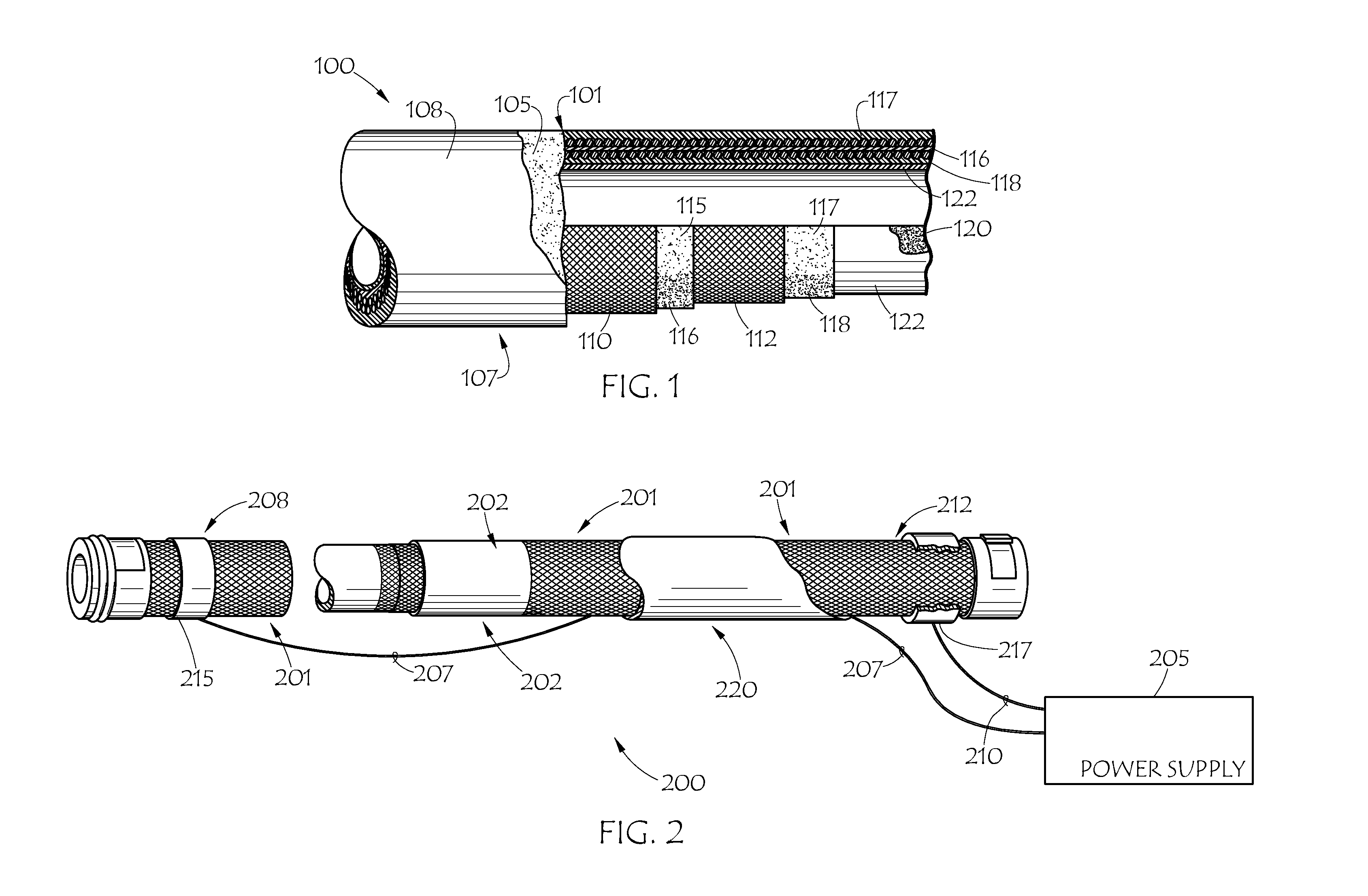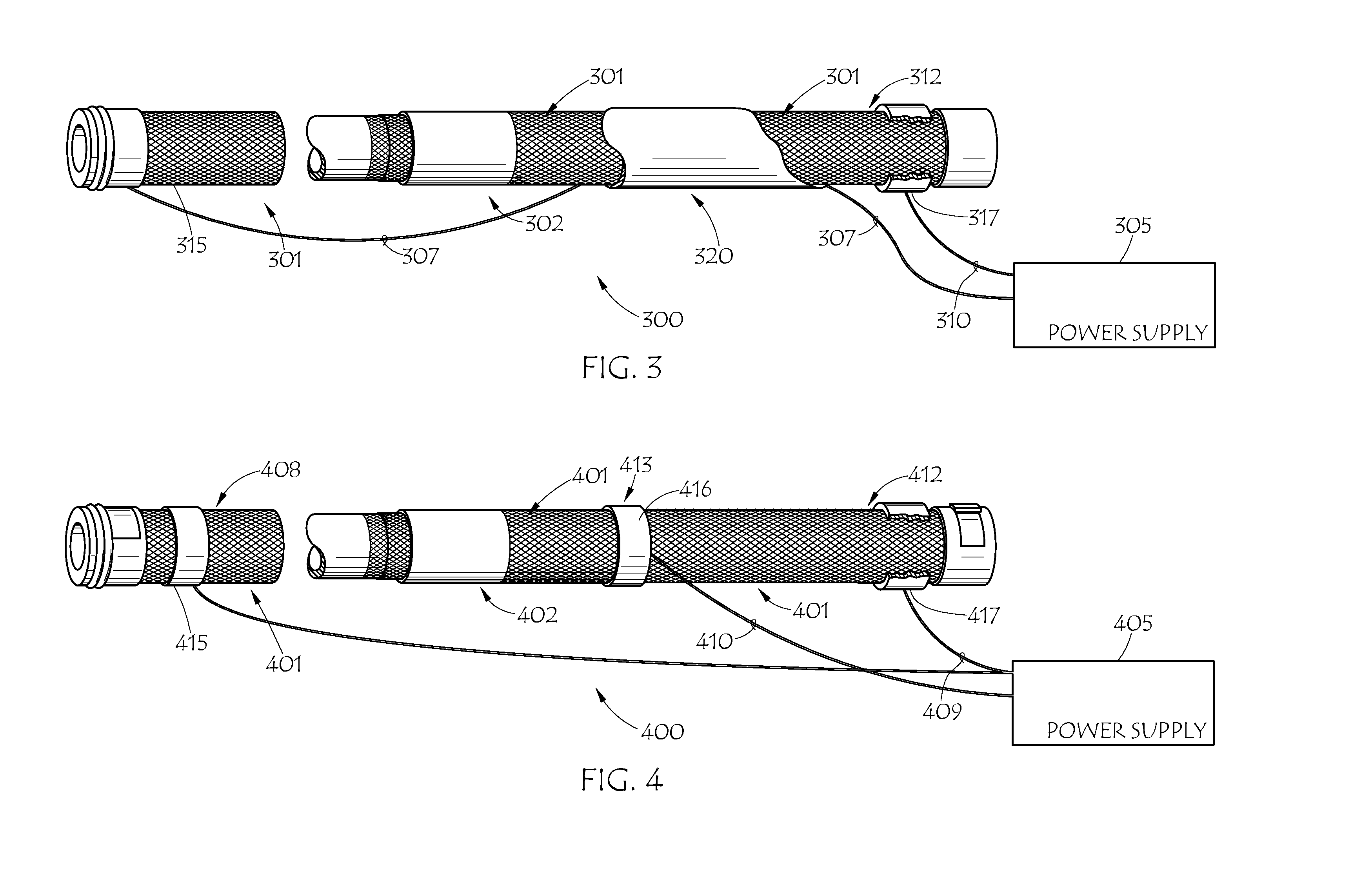Heated fluid conduit end covers, systems and methods
- Summary
- Abstract
- Description
- Claims
- Application Information
AI Technical Summary
Benefits of technology
Problems solved by technology
Method used
Image
Examples
embodiment 800
[0045]FIGS. 5, 6 and 7 are perspective illustrations of embodiments of covers 500, 600 and 700 for use with various embodiments of the present heated fluid conduits and / or fluid conduit heating systems. FIG. 8 is a partially fragmented illustration of embodiment 800 of a fluid conduit heating system in accordance with the present invention employing coupling covers similar to cover 500 and 600 illustrated in FIGS. 5 and 6.
[0046]Covers 500, 600 and 700 provide protection and insulation for quick-connect couplings and wiring, such as conductors 807 and 810, associated with a heated fluid conduit in accordance with various embodiments of the present invention. The embodiments of covers 500, 600 and 700 shown are comprised of paired molded plastic parts, placed together to form a hard protective coverings for the couplings and the wiring. The illustrated covering embodiments each comprise two pieces, which are generally mirror images of each other, 501 and 502, 601 and 602, and 701 and ...
embodiment 900
[0051]FIG. 9 is a partially fragmented illustration of embodiment 900 of a heated fluid conduit of the present invention employing molded end covers 901 and 902. In accordance with the present invention, heated fluid conduit 900 might, similar to conduit 100, have a body with a semi-conductive material disposed therein and one or more wires 905 and 906 coupling electrical power supply 908 to the conduit to provide a voltage across the conduit and an electrical current therethrough to heat the fluid conduit. However, conduit 900 also employs end covers 901 and 902, molded over a fitting or the like fitted to an end of the conduit. Overmolded end covers 901 and / or 902 may also be molded over an end of wire 905, facilitating coupling of power supply 908 to an end of the conduit. Similar to as discussed above, electrical power supply 908 may be coupled to each end of the conduit, and also possibly another terminal of the electrical power supply may be couple to the conduit at one or mor...
embodiment 1000
[0053]FIG. 10 is a perspective illustration of embodiment 1000 of a fluid conduit heating system in accordance with the present invention employing molded fitting covers 1001 and 1002. fluid conduit heating system 1000, may employ semi-conductive sleeve 1005 disposed over fluid conduit 1010 with sleeve 1005 extending at least partially over a fitting fitted to an end of conduit 1010. Electrical power supply 1008 may be coupled to each end of sleeve 1005 to provide a voltage across sleeve 1005 and a resulting electrical current through semi-conductive sleeve 1005 to heat sleeve 1005 and fluid conduit 1010, within. End covers 1001 and 1002 are preferably molded over at least a portion of the fitting and the sleeve extending thereover. At least one of the terminals of electrical power supply 1008 is preferably coupled to ends of sleeve 1005, such as by wires 1006 and 1007, and one terminal of the electrical power supply may be coupled to sleeve 1005 at one or more points therebetween, ...
PUM
 Login to View More
Login to View More Abstract
Description
Claims
Application Information
 Login to View More
Login to View More - R&D
- Intellectual Property
- Life Sciences
- Materials
- Tech Scout
- Unparalleled Data Quality
- Higher Quality Content
- 60% Fewer Hallucinations
Browse by: Latest US Patents, China's latest patents, Technical Efficacy Thesaurus, Application Domain, Technology Topic, Popular Technical Reports.
© 2025 PatSnap. All rights reserved.Legal|Privacy policy|Modern Slavery Act Transparency Statement|Sitemap|About US| Contact US: help@patsnap.com



